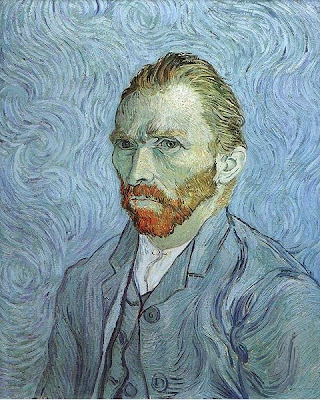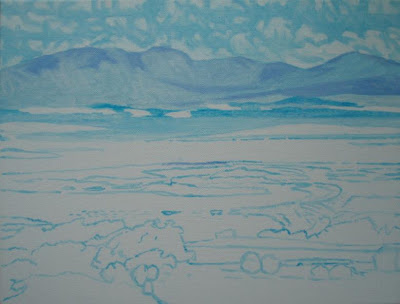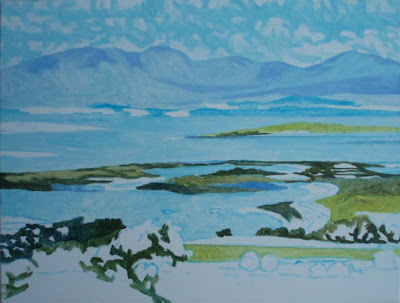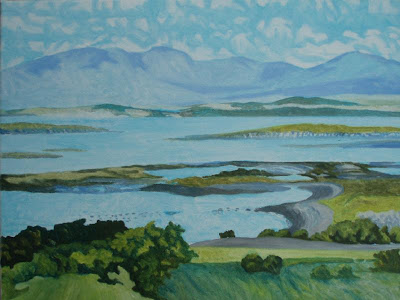
Vincent Van Gogh
If Vincent Van Gogh had been alive today, he would probably have one of the largest blogs on the net. Not sure if it would be popular, considering his state of mind. During his brief life, a mere 37 years, he wrote 18 years of letters to his brother Theo alone, not to mention other relatives and friends. He is generally regarded as the most important painter since Rembrandt, influencing greatly the modern expressionist movements. He has achieved mythological status in the public imagination due to fitting the mould of the starving tortured artist.
Vincent was born on 30th March 1853 in Groot - Zundert in the Netherlands, eldest of six, his father was a protestant pastor. His brother Theo was born on 1st May 1857. Vincent attended boarding school as a child from 1864-68, before returning to his parents in Zundert. He was solitary by nature, often spending time in the open countryside near his hometown. In 1869 he started work as a junior clerk for the art firm of Goupil and Co. in the Hague, where he uncle was a partner. In 1873 he was transferred to it's London branch. While there, he lodged with Sarah Loyer and he fell in love with her daughter, Eugenie. However, after declaring love out of the blue one day to her after several months of living in the house, he was rebuked with vigour as she told him she was engaged to a man who was working at sea, and she was waiting for his return. Vincent took it badly and returned to Holland for 3 weeks and was then moved to the Paris branch of Goupils temporarily much to his dislike. In 1875, he was temporarily returned to the London branch before being permanently assigned to Paris. In 1876, he was let go from Paris due to the inefficient manner of his work, and he decided to return to England. After his rebuke in London, he had become increasingly solitary. He began to seek work as an elementary teacher and taught basic french, english and mathematics in schools in Ramsgate and Isleworth. He also took the notion to help in the local parish and sometimes preached there as a lay minister. In 1877 he returned to Holland, worked for a while in a bookshop and took a brief study in theology in Amsterdam, before quitting in 1878 to study at a school for evangelists in Brussels. After clashing with them over their teachings, he returned to his parents home in Holland, before heading for the Borinage, Belgium. This was a very poor coal-mining area, where the inhabitants lived in squalor. Here, he obtained a mission post but in the winter of 1879-80 in an impassioned moment, he took it upon himself to give away all his possessions to the poor inhabitants, in a liberal interpretation of Christian teachings. He was dismissed by church authorities. This was a turning point, and the first of several spiritual crisis in his life. He continued to preach for a while but his true calling was at last becoming clear to him.
Having fallen into despair over the scandal surrounding his attempt to live a truely Christian message, he began drawing seriously for the first time in his life. He drew the people of the Borinage. As they lived in dark, dirty surroundings and always worked underground, Vincent portrayed them using a dark and sombre palette. He decided to become an artist. It was 1880, he was penniless, and he had no formal training in this new career path. Through this new venture into art, he began to rediscover his confidence, although his outlook on life remained darkened by the previous events he had experienced. He visited the Brussels Academy and studied fine art there. In 1881, he returned to where his father was pastor, then Etten, Netherlands, where he painted nature. While in Etten he fell in love with his widowed cousin Kee Vos Stricker, but she rejected his advances. He continued to study art and worked hard to improve. Working in watercolours and drawing, he found he needed to learn from others. In late 1881, he studied with Anton Mauve in the Hague, a landscape artist. In 1882 he lived in a small apartment with a prostitute called Sien and her 5 year old daughter in the Hague, and this lasted for a year. He began to paint in oils that year for the first time. In 1883 having split from Sien, he felt the need to return to nature and spent three months in Drenthe, an isolated region of northern Holland frequented by artists. After this he returned to Neunen village, where his parents were now living. In 1883 in Neunen he had a love affair with an older woman Margo Begemann, which lead to a scandal and her attempted suicide. He was to remain in Neunen for the most of 1884 and 1885. All this time he was improving as a painter. His main subjects were still-life, landscape and figures. In March of 1885 his father, Reverend Theodorus van Gogh died.
In 1886 Vincent enrolled at the Academy at Antwerp, where he studied painting and drawing. He worked from live models. During this year he became inspired by the work of Hals and Peter Paul Rubens and how they expressed mood using colour. At the same time, he discovered Japanese art prints and impressionist painting. He began to move away from his dark coloured palette and tried painting more colourfully. All the outside influences impacting on his art moved him into conflict with those he encountered at the Academy and after 3 months he left abruptly to join his brother Theo in Paris. Theo was involved in the world of art dealing. In Paris, Vincent met Henri de Toulouse-Lautrec and Paul Gauguin. In 1887, Theo introduced him to Georges Seurat and Camille Pissarro and other impressionist artists. He became friends with Camille. He painted outdoors along the banks of the Seine with Paul Signac. All the time his style was forming it's own hallmark. From spring 1886 until early 1888 his work transformed. Through the summer of 1887 his work became less traditional and more pure colour, broken brushwork and freer in all aspects. By 1888, his post-impressionist style was emerging in it's entirety. After almost two years in the city, Vincent now longed for the countryside again. In February of 1888, he left Paris and moved to Arles in the south east of France, where he could be free to paint the colours and tones of the rural landscape.
In the next 12 months in Arles, Vincent entered his first great painting period, painting sunflowers and landscapes, cherry blossoms, his friend Roulin the postman, self-portraits, other friends, views of the town, his place of lodging at the "yellow house" and everything he could see.
He was aware of how different he was from other artists in style. He wanted to persuade them to join him in Arles and start a school of painters there. He persuaded Gauguin to join him in October. For three months they worked together, but they were vastly different in temperament. Arguments were frequent as Vincent became more unstable and eccentric in personality. It came to a head on Christmas eve 1888, when after a heated argument where Vincent threatened Gauguin with a razor, Vincent cut off the lower part of his own ear and presented it to a woman named Rachel at the local brothel, with instructions to give it to Gauguin. Theo came to Arles but left with Gauguin for Paris two days later. Vincent spent two weeks in hospital.
Afterwards, Vincent recovered for a while and painted for several more weeks. He painted
Self-Portrait with pipe and bandaged ear and still lifes. In April 1889, after several repeated mental disturbances he felt his sanity slipping and decided to admit himself to an asylum at Saint-Remy-de-Provence. He remained there for a further twelve months, during which he alternated between sanity and recurrences of mental instability. His world consisted of the asylum garden and his cell, but he depended on the asylum treatment to maintain his grip on reality. He painted intermittantly, trying to paint in a calmer way, to surpress his more out of control emotional style of the previous summer. He used more muted colour and replaced it with dynamic forms and vigorous line brushstrokes. He resisted painting from memory, something which Gauguin had encouraged him to do. He painted
Cypresses, Olive trees and
Garden of the Asylum at this time. The overall feel of the paintings produced at this time was one of sadness and struggle, but the paintings had a stronger vision than those of Arles.
Finally in May of 1890 Vincent discharged himself. He was homesick and lonely for the north of Europe and to see his brother Theo. Theo had married Johanna Bonger the previous year and they had had a son Vincent Wilhelm van Gogh in January 1890. Vincent arrived in Paris and after four days visiting Theo, he went to Auvers-sur-Oise to visit with a homeopathic doctor friend of Camille Pisarro and Paul Cezanne. This was Dr. Paul Ferdinand Gachet who began to take care of Vincent. The place was a village community similar to his parents village of Neunen, where he had not stayed for four years. Vincent felt at home and enthusiastically painted again, painting corn-fields, the village houses, the church and the town hall. Using large brushstrokes and a cooler palette, reflecting the northern climate he created very expressive works. However, his mind was still troubled. This short period of creativity ended in fights with Dr.Gachet. Vincent despaired over his sanity and his inability to succeed at his career. He also felt guilt at being financially dependent on Theo's generosity.
On July 27th in a corn field, outside of Auvers, amid feelings of helplessness of ever being cured and compounded by years of loneliness, Vincent shot himself in the stomach. He managed to crawl back to the inn, where he was staying. Two days later, with Theo by his side, he died. He was buried in Auvers.
Later that year Theo organised a small exhibition of Vincent's work in an apartment in Montmatre, Paris. But Theo's own health deteriorated and he died in Jan 1891 in the Netherlands. His remains were buried in a grave alongside his brother's grave in Auvers.
Vincent created 800 paintings and 700 drawings during the 10 years of his life as an artist. He sold only one. His life was consumed by his commitment to his art and he survived on the generosity of his brother Theo. In 1888 -1890 a few of his paintings had been exhibited at the Salons de Independents in Paris, and the same Salon in Brussels in 1890, but when he died he was essentially an unknown artist. In 1891, both Salons showed a commemorative exhibition of his work, but it was 1892 before his work was shown as a one person show. By the early 20th Century however, his work became widely accredited. The letters he wrote to Theo from 1872 onwards and to other friends and relations, provided an amazing in-depth view into his life. His hopes, despairs, views and beliefs, all are revealed in these letters. Through them the world came to know who Vincent was.
That's a long post today, but it's condensing a very long story in my own words. I shall post other articles on famous artists in future, where they are relevant to my work. I consider Van Gogh's work to be a source of inspiration to me and that is why I posted this article. If you want to read more detail of his life, why not try the book "Lust for Life" by Irving Stone. Or there or lots of other places to read about him, I'm not endorsing any!
 Oil Painting Demonstration - Irish Landscape
Oil Painting Demonstration - Irish Landscape  Painting the Undercoat
Painting the Undercoat Mixing Green in Landscape Painting
Mixing Green in Landscape Painting For the grey of the beach areas, you can use a combination of ultramarine blue with raw umber, or cobalt blue with raw umber. The grey can be lightened with titanium white. It's also good to try varying colours away from what you see in the photo. I tried a little area of more purple shade on some beach areas, using ultramarine blue with raw umber.
For the grey of the beach areas, you can use a combination of ultramarine blue with raw umber, or cobalt blue with raw umber. The grey can be lightened with titanium white. It's also good to try varying colours away from what you see in the photo. I tried a little area of more purple shade on some beach areas, using ultramarine blue with raw umber.


















 Having completed the "undercoat" last week, and allowing it to dry, I now wanted to go over the entire picture, increasing and refining the detail where necessary. Much of the work I am doing in this stage will be harder to see, between photos but it is there if you look closely. Sometimes it's just an additional layer of paint to reinforce the colour where it was patchy, in other cases you can see more detail added. Compare the photos carefully to see the gradual changes.
Having completed the "undercoat" last week, and allowing it to dry, I now wanted to go over the entire picture, increasing and refining the detail where necessary. Much of the work I am doing in this stage will be harder to see, between photos but it is there if you look closely. Sometimes it's just an additional layer of paint to reinforce the colour where it was patchy, in other cases you can see more detail added. Compare the photos carefully to see the gradual changes.
















 Technology is wonderful! Digital photography has really freed up a lot of the time needed to gather reference material. Of course, there is always the Plein air approach, something I never really tried, due to the unpredictable climate we have here in Ireland. Actually, to be honest, we don't have a climate, we just get weather, and lot's of it!! You never know what it's going to do next. Not sure what day summer is on this year, but will make the most of it.
Technology is wonderful! Digital photography has really freed up a lot of the time needed to gather reference material. Of course, there is always the Plein air approach, something I never really tried, due to the unpredictable climate we have here in Ireland. Actually, to be honest, we don't have a climate, we just get weather, and lot's of it!! You never know what it's going to do next. Not sure what day summer is on this year, but will make the most of it. 

 Seeing all these beautiful reference photos, I feel ready to start another painting, so keep checking in to see some work as I progress. And feel free to check out my
Seeing all these beautiful reference photos, I feel ready to start another painting, so keep checking in to see some work as I progress. And feel free to check out my 

